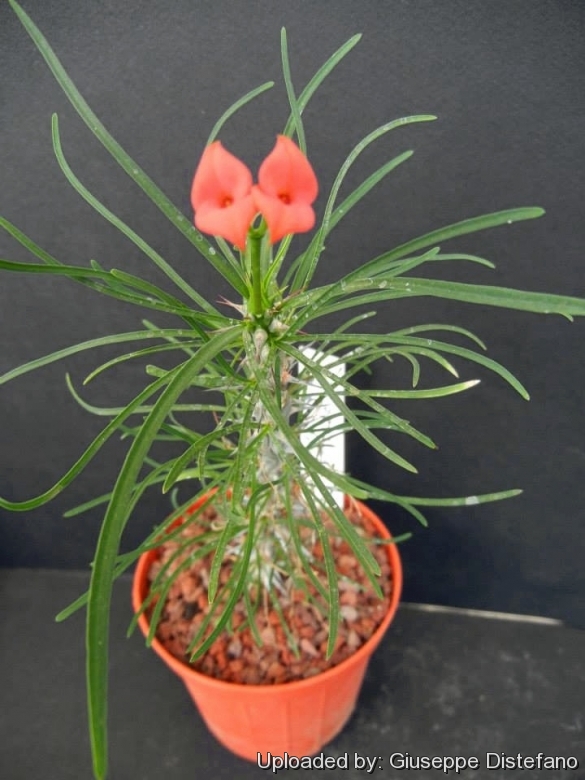
Euphorbia gottlebei Photo by: Giuseppe Distefano
Origin and Habitat: Southwest of Madagascar. This species is only known from the type locality Fiherenana valley, west of Sakaraha.
Habitat and Ecology: Euphorbia gottlebeiSN|25959]]SN|25959]] grows on steep limestone slopes in subarid deciduous thorny thickets. It is likely to have a very restricted range. Major Threats are habitat degradation, fire, collection for the national and international horticultural trade. The zone is characterized by high temperatures and distinct wet and dry seasons, but precipitation is scarce. The plants loose their leaves and flourish during the short dry season (mostly from July to August).
Synonyms:
Description: Euphorbia gottlebeiSN|23360]]SN|25959]] is a very spiny shrubby Euphorbia looking like a miniaturized Euphorbia miliiSN|25959]]SN|23360]], but can still reach a 1,5 metres in height.
Habit: It is a laxly branched shrubs.
Root: It has a long tap root.
Stem: Primary stems to 2 cm thick, densely spiny and branching annually. Thorn up to 1,5 cm long short and stiff with a wide base. The short twigs (Spurs) that also appear among the thorns on the stem leaves are short (up to 3 cm long).
Leaves: Found mainly on new growth, shedding seasonally during the dry season, narrow and slender up to 6 cm long forming a compact canopy.
Inflorescence: The inflorescences, bearing 4 to 16 small carmine flowers, are produced below the branch-tips.
Flowers (cyathia): Small, subtended by a pair of conspicuous petal-like bracts, usually orange-red, but several colour variants comprising dark-red, yellow, pink, etc. has been develop in cultivation. The female organs (ovaries and stigmas) mature firstly, later replaced by the male stamens with pollen on short anthers.
Fruit: If the flower is pollinated, the stamens dry, and a shine green fruit (a triangular capsule) with three round seeds ripens in the warm days.
Bibliography: Major references and further lectures
1) Werner Rauh, Herman Schwartz “Succulent and xerophytic plants of Madagascar” Volume 2 Strawberry Press, 1998
2) Urs Eggli “Illustrated Handbook of Succulent Plants: Dicotyledons” Volume 2. Springer, 2002
3) Haevermans, T. 2004. Euphorbia gottlebei. In: IUCN 2013. "IUCN Red List of Threatened Species." Version 2013.2. <www.iucnredlist.org>. Downloaded on 19 January 2014.
4) Cactus Succ. J. (Los Angeles) 64:15. 1992
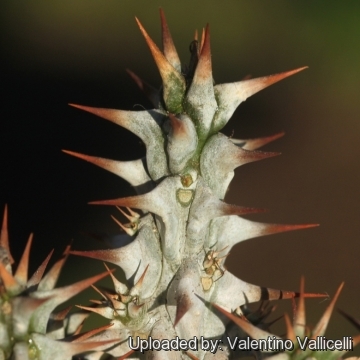 Euphorbia gottlebei Photo by: Valentino Vallicelli
Euphorbia gottlebei Photo by: Valentino Vallicelli Euphorbia gottlebei Photo by: K.k. Agrawal
Euphorbia gottlebei Photo by: K.k. Agrawal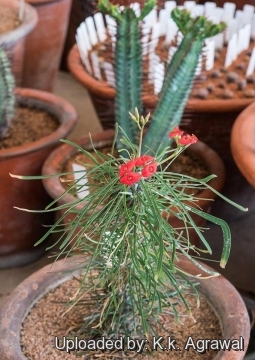 Euphorbia gottlebei Photo by: K.k. Agrawal
Euphorbia gottlebei Photo by: K.k. Agrawal Euphorbia gottlebei Photo by: Giuseppe Distefano
Euphorbia gottlebei Photo by: Giuseppe Distefano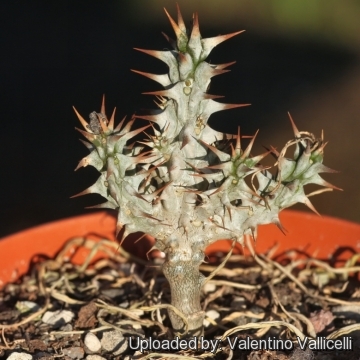 Euphorbia gottlebei Photo by: Valentino Vallicelli
Euphorbia gottlebei Photo by: Valentino Vallicelli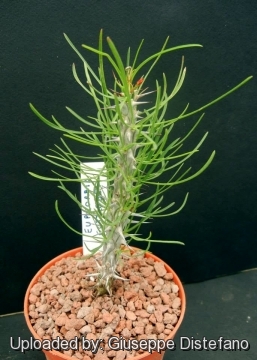 Euphorbia gottlebei Photo by: Giuseppe Distefano
Euphorbia gottlebei Photo by: Giuseppe Distefano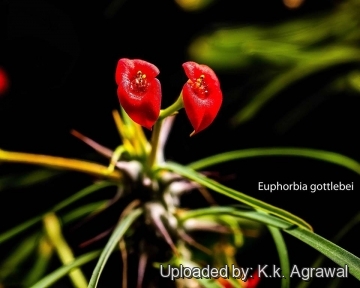 Euphorbia gottlebei Little chaps, hardly 5 mm Photo by: K.k. Agrawal
Euphorbia gottlebei Little chaps, hardly 5 mm Photo by: K.k. Agrawal Euphorbia gottlebei Photo by: Valentino Vallicelli
Euphorbia gottlebei Photo by: Valentino VallicelliCultivation and Propagation: Euphorbia gottlebeiSN|25959]]SN|25959]] is a slow-growing and cold-sensitive species, it can to grow in both pots and in the ground, in areas with a mild climate, but they can even be grown indoors. They grow well in a very draining mineral potting substrate. During the summer, they enjoy average feeding and watering.
Hardiness: When dormant, plants are relatively cold-tolerants, but for safe cultivation it is best to avoid temperatures below 10° C.
Sun Exposure: Light shade.
Propagation: Usually by seeds, it can also It be propagated by cuttings; if you remove an offset, remember to let it dry for a week or so, letting the wound heal (cuttings planted too soon easily rot before they can grow roots). It is better to wash the cut to remove the latex.
Warning: As with all other Euphorbias, when a plant gets damaged it exudes a thick white milky sap known as latex. This latex is poisonous and may irritate skin, so pay extreme attention not to get any in your eyes or mouth.
Cultivated plants must be handled carefully.
Your Photos

by Giuseppe Distefano




















